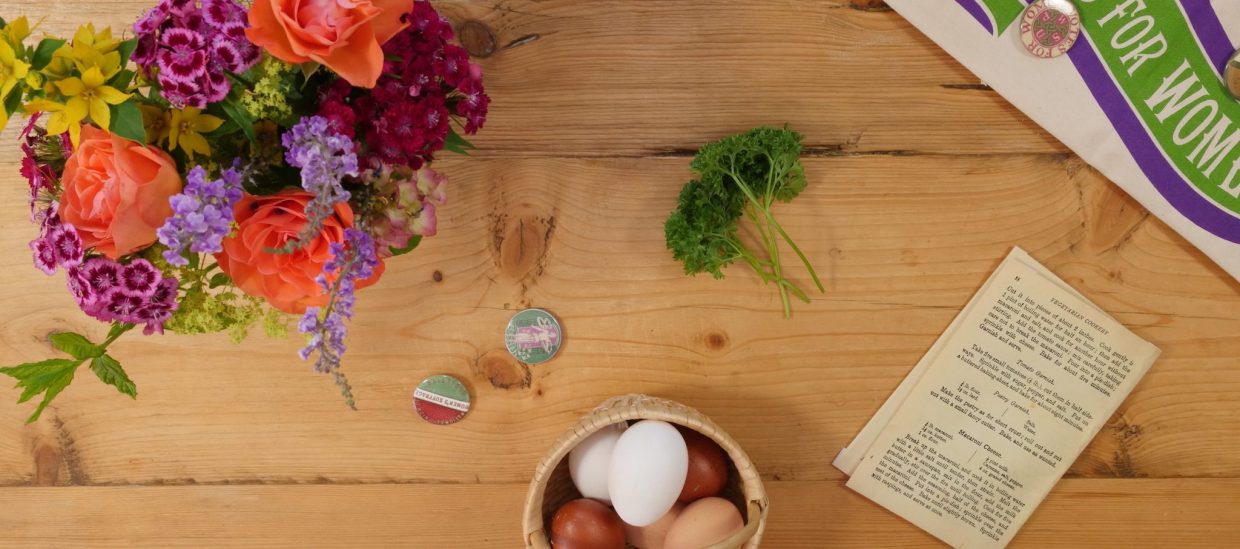LOUISE QUICK
CONTENT PRODUCER & PUBLIC HISTORIAN

Repost: how the way to the public’s heart is through their stomach
19 July 2019
Four of my all-time favourite things are food, history, food history, and dogs. The last one is irrelevant to this post, but fortunately I combined the three former interests in a blog post all about using food in public history recently.
Inspired by my MA project Suffrage Eats, the post was for Bridging, the blog for the International Federation for Public History. You can check out the original post on their site, but I had such fun writing it – and not only because of the food-based pun opportunities – so popped it on my site too.
Now, to find an opportunity to write about the history of dogs…
HISTORICAL FOOD FOR THOUGHT: HOW THE WAY TO THE PUBLIC’S HEART IS THROUGH THEIR STOMACH
I love food. It’s not a mind-blowing statement, I know. Eating is an enjoyable – and necessary – part of human existence. It’s one of the great common denominators throughout human history: we all have to eat and we always have. Even Mahatma Ghandi, Jane Austen, Winston Churchill and Boudicca would have woken up wondering: ‘what’s for breakfast?’.
It’s this that makes food such an exciting tool for public historians. It can help communicate history at a level that’s accessible and where everyone is welcome – it takes history out of its ivory tower and serves it at the dinner table.

(Credit: Shane Rounce on Unsplash)
It’s strange then that food is still relatively fresh on the public history scene. It’s on the rise, however, and this is arguably thanks to the growth of social history that we have seen since the 1960s, as well as the demand for more hands-on activities and re-enactment across museums and historical institutions.
The Tenement Museum in New York is one big-name institution that appreciates the value food can bring to public history. Its ‘Food of the Lower East Side’ tour takes guests on a “walking-and-tasting tour explor[ing] the neighbourhood through the culinary traditions of a community that called the Lower East Side home”. Historian Adam Steinberg has explored the significance of multi-sensory experience in communicating history and explains how taste can “heighten the power of the story” being told.*
Even in the digital world, where taste isn’t directly possible, food is no less powerful a tool. English Heritage’s YouTube series, The Victorian Way, has amassed a dedicated following who tune in to watch the 19th century chef, Mrs Avis Crocombe, recreate real Victorian recipes. Through this series of charming cooking tutorials, which boasts more than 1.6 million views, English Heritage educates viewers on wider Victorian social history as well history of the site, Audley End House in Essex.
Furthermore, the videos’ busy comment sections see viewers engage with history as they debate topics and ask ‘Mrs Crocombe’ questions. Clearly there is an audience out there eager to learn history, as long as it’s served in a way that’s palatable, relatable and, ideally, alongside home-baked Victorian gingerbread.
My own recent project, Suffrage Eats, looked at the prominence of vegetarianism within the British Suffrage movement through a series of cookery videos. Each digital cooking tutorial recreated real vegetarian recipes from the late-Victorian and Edwardian era. The focus, however, was less on the food itself and more on using it as a vehicle to send a strong historical message.
Luckily, anyone looking for historical recipes will find themselves spoilt for choice. London’s Wellcome Library boasts a mighty collection of recipe books from as early as the 16th century – many which are freely available online – and includes a healthy batch of vegetarian cookbooks.
This proved invaluable for Suffrage Eats. Sifting through these archives and cross-referencing the cookbooks with other primary evidence, including interview recordings and written accounts, led to a strong shortlist of recipes relevant to my project.
However, from here one less-than-academic factor came into play: how appetising is the dish. Good public history prioritises its audience so, in appealing to 21st century viewers, I choose dishes familiar to them, dishes they could actually see themselves making. As such, recipes for ‘macaroni cheese’ won out over ‘timbale of colcannon’. The final choices were both historically sound, (macaroni was a popular late-Victorian vegetarian ingredient), while also being familiar and appealing to a wide audience.
The subsequent online cookery videos feature history ‘pop-ups’, informative written summaries, as well as accompanying blog posts and social media accounts, all providing greater historical context.
Turns out, a tutorial for Edwardian macaroni cheese is an effective way to convey some substantial history around the women’s suffrage movement. The foodie element helped the history reach a wider and more diverse audience than perhaps a simple article or traditional presenter-led video would have.
One personal favourite pieces of feedback Suffrage Eats received stated: “Suffragettes – they’re just like us! […] who knew people in the past even had a diet, let alone made conscious choices about being vegetarian”. This shows that, as well as being a good vehicle for history, food can humanise history and those that inhabited it.
By looking at what historical characters, such as the Suffrage campaigners, ate helps modern audiences see them for what they really were: not semi-fictional heroic protesters living in the foreign land of the past, but multifaceted and relatable humans who would wake up in the morning wondering: ‘what’s for breakfast?’.
*Adam Steinberg, ‘What We Talk About When We Talk About Food: Using Food to Teach History at the Tenement Museums’, The Public Historian, Vol 34, No 2 (Spring 2012)
< Back to all posts